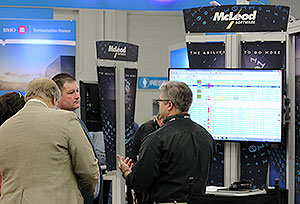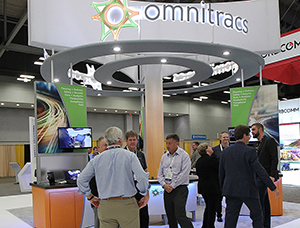Managing Editor, Features and Multimedia
Blockchain Not Yet Mature, but Digital Ledger Holds Promise for Transportation

AUSTIN, Texas — Blockchain has been the subject of extensive hype and much confusion, but this distributed general ledger technology holds the potential to boost efficiency and visibility in the transportation sector as the initial excitement gives way to real business cases, according to trucking technology experts.
At the moment, however, blockchain is not yet a mature technology, particularly within the transportation industry, executives from McLeod Software and Omnitracs said here Oct. 29 at an educational session during American Trucking Associations’ Management Conference & Exhibition.
Currently, the financial industry is leading the way in blockchain investment, but in this case being first is not necessarily the best, said Brad Taylor, vice president of data engineering, AI and machine learning at Omnitracs.
As the financial sector continues to invest in blockchain to move it “out of the wilderness” and make it into a real platform for its own use, that groundwork also will help pave the way for the technology in other industries, including transportation.
“We’ll benefit from other people’s investments and the maturity of the process and then go forward with more specific use cases for our business,” Taylor said. “They spend the money; we get the foundation for what we want to do.”
While blockchain originally was devised to support bitcoin, its potential applications extend far beyond cryptocurrency. This digital ledger — protected by encryption and stored separately by all participants in a network — could increase transparency and reduce the friction of doing business in many industries.

A view of the McLeod Software booth on the exhibit floor. (John Sommers II for Transport Topics)
Taylor pointed to several potential uses for blockchain in transportation, including compliance tracking, transparency for payments and pricing, chain of custody for pharmaceuticals and tracing refrigerated freight.
Some early applications of blockchain already have begun to appear in the supply chain.
“We’re seeing movement now, not just in the financial markets, but in the [business-to-business] world — in our world,” said Ken Craig, vice president of special projects at McLeod Software.
Walmart Inc., for example, recently announced that it will require its leafy green suppliers to track their produce from farm to store on its blockchain platform.
“This is a large proof-of-concept blockchain that is now headed into our industry,” Craig said. Nonetheless, the technology faces several challenges, he added.
Public blockchains currently are limited to 3-20 transactions per second, while Visa, for example, is capable of about 56,000, Craig said.

A view of the Omnitracs booth. (John Sommers II for Transport Topics Magazine)
Other concerns include data privacy and the need for collaboration and interoperability.
Craig and Taylor are board members at the Blockchain in Transport Alliance, which is working to develop standards for the use of blockchain in this industry.
In the meantime, transportation executives will need to navigate the hype surrounding blockchain.
Craig referenced the “hype cycle for emerging technologies” as defined by Gartner Inc., which last year suggested that blockchain was beginning to leave the “peak of inflated expectations” and was moving into the “trough of disillusionment,” leading eventually to the realization of true productivity gains.


